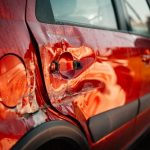The Most Common Types of Collision Damage
December 13, 2023 6:19 pm Leave your thoughts Getting into a vehicle collision can be a stressful and unnerving experience. In addition to the potential injuries and emotional distress, your vehicle may suffer damage that needs to be repaired. It’s essential to understand the different types of collision damage that can occur to ensure you have a comprehensive understanding of the repairs needed. In this blog post, we will educate you about the most common types of collision damage and what they entail.
Getting into a vehicle collision can be a stressful and unnerving experience. In addition to the potential injuries and emotional distress, your vehicle may suffer damage that needs to be repaired. It’s essential to understand the different types of collision damage that can occur to ensure you have a comprehensive understanding of the repairs needed. In this blog post, we will educate you about the most common types of collision damage and what they entail.
1. Structural Damage
One of the most severe types of collision damage is structural damage. This refers to damage or deformation to the vehicle’s framework or chassis. Structural damage can occur when the force of impact is significant, such as in high-speed accidents or collisions with solid objects. Signs of structural damage include misaligned doors or panels, uneven gaps between body parts, or a visible shift in the overall body shape.
Repairing structural damage often requires specialized equipment and expertise. Professional auto body repair technicians will use frame straightening techniques and computerized measuring systems to realign the vehicle’s structure and restore its integrity. It is crucial to address structural damage promptly to ensure the vehicle’s safety and proper functionality.
2. Body Panel Damage
Body panel damage is one of the most common types of collision damage, often resulting from minor fender benders and parking lot mishaps. This damage typically affects the outer parts of the vehicle, such as the bumper, hood, doors, fenders, and trunk. Dents, scratches, and creases on these surfaces are typical signs of body panel damage.
Repairing body panel damage can involve various techniques, depending on the extent of the damage. Minor dents may be fixed using paintless dent repair (PDR), which involves manipulating the dent from the inside without the need for paint or body filler. For more significant damage, auto body repair technicians will use a combination of techniques like fillers, sanding, priming, and painting to restore the damaged panels to their original condition.
3. Paint Damage
In a collision, the vehicle’s paint can suffer damage, including chipping, peeling, or scratching. Paint damage can expose the vehicle’s metal surface, leading to an increased risk of rust and corrosion over time if left unattended.
To repair paint damage, the affected area may need to be sanded down, smoothed, and repainted. This process involves matching the existing color and applying several layers of paint and clear coat to blend seamlessly with the rest of the vehicle’s surface. Professional auto body repair technicians have the skills and equipment to achieve an accurate color match and ensure a seamless and long-lasting paint repair.
4. Glass and Window Damage
Collisions can also cause damage to a vehicle’s glass and windows. From minor chips and cracks to shattered windows, this type of damage can impair visibility and compromise the structural integrity of the vehicle.
In many cases, small chips and cracks can be conveniently repaired using specialized resins and tools by experienced professionals. However, severe damage that results in shattered or broken glass generally requires complete window replacement. Auto glass specialists are equipped to handle these repairs and replacements with precision and ensure that the vehicle’s glass is restored to its original condition.
5. Suspension and Alignment Damage
During a collision, the vehicle’s suspension and alignment components can suffer damage. This can affect the vehicle’s stability, steering, and smoothness of the ride. Signs of suspension and alignment damage often include uneven tire wear, pulling to one side, or a noticeable difference in the vehicle’s handling.
Repairing suspension and alignment damage typically involves a thorough inspection by a knowledgeable technician. They will check for bent or damaged components and perform adjustments or replacements as necessary. Ensuring proper suspension and alignment are crucial for maintaining the vehicle’s safety and driveability.
Summary
Understanding the different types of collision damage is vital for comprehending the extent of repairs needed after an accident. Structural damage, body panel damage, paint damage, glass and window damage, as well as suspension and alignment damage, are common issues that require professional attention for proper repair. Consulting with experienced auto body repair technicians will not only help restore your vehicle’s appearance but also ensure its safety and performance on the road. Remember, addressing collision damage promptly will help maintain the value and longevity of your vehicle while providing you with peace of mind.
Need an Auto Body Shop in Middletown, NJ?
Family owned and established in 1953, Lentz Auto Body has been serving Belford and Middletown for over 60 years. Here at Lentz Auto Body, we provide superior, experienced service for your vehicle. Now with all new ownership and management, Lentz Auto Body is your one-stop shop for all things collision repair and body work. Some of our major services include collision and auto body repair, dent repair, auto restoration, auto painting, custom auto painting, car detailing, and more! If you need collision repair or auto body services in Middletown, give us a call or stop in today for an estimate. Our friendly staff and professional mechanics are here, waiting to assist you!
Categorised in: Auto Body Painting, Auto Body Repairs, Auto Body Shop, Auto Detailing, Auto Painting, Auto Restoration, Collision Repair, Dent Repair
This post was written by admin
